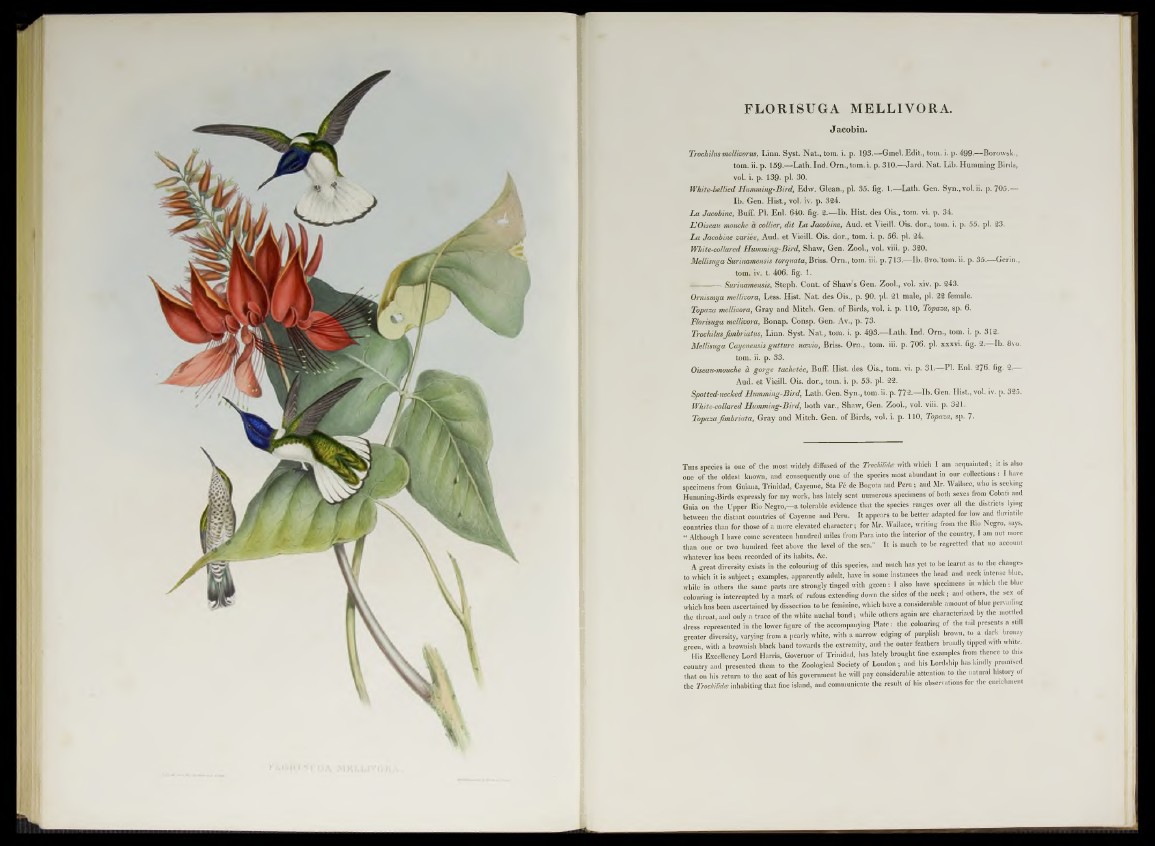
FLORISUGA MELLIYORA.
J acobin.
Trochilus mellivorns, Linn. Syst. Nat., tom. i. p. 193.—Gmel. Edit., tom. i. p. 499-—Borowsk.,
tom. ii. p. 159.—Lath. Ind. Orn.,tom. i. p. 310.—Jard. N at. Lib. Humming Birds,
vol. i. p. 139- pl. 30.
White-bellied Humming-Bird, Edw. Glean., pl. 35. fig. 1.—Lath. Gen. Syn.,vol.ii. p. 705.—
Ib. Gen. Hist., vol. iv. p. 324.
L a Jacobine, Buff. Pl. Enl. 640. fig, 2g - I b . Hist. des Ois., tom. vi. p. 34.
L'Oiseau mouche a collier, dit La Jacobine, Aud. et Vieill. Ois. dor., tom. i. p. 55. pl. 23.
L a Jacobine variée, Aud. et Vieill. Ois. dor., tom. i. p. 56. pl. 24..
White-collared Humming-Bird, Shaw, Gen. Zool., vol. viii. p. 320.
Mellisuga Surinamensis torquata, Briss. Om., tom. iii. p. 713.—Ib. 8vo.'tom. ii. p. 35.—Gerin.,
tom. iv. t. 406. fig. 1.
—----------- Surinamensis, Steph. Cont. of Shaw s Gen. Zool., vol. xiv. p. 243.
Ornismya mellivora, Less. Hist. Nat. des Ois., p. 90. pl. 21 male, pl. 22 feraale.
Topaza mellivora, Gray and Mitch. Gen. of Birds, vol. i. p. 110, Topaza, sp. 6.
Florisuga mellivora, Bonap. Consp. Gen. Av., p. 73.
TrochilusJimbriatus, Linn. Syst. Nat., tom. i. p. 493.—Lath. Ind. Orn., tom. i. p. 312.
Mellisuga Cayenensis gutture nccvio, Briss. Orn., tom. iii. p. 706. pl. xxxvi. fig. 2, Ib. 8vo.
tom. ii. p. 33.
Oiseaurmouche d gorge tachetèe, Buff. Hist. des Ois., tom. vi. p. 31. Pl. Enl. 276. fig. 2.
Aud. et Vieill. Ois. dor., tom. i. p. 53. pl. 22.
Spotted-necked Humming-Bird', Lath. Gen. Syn., tom. ii. p. 772.—Ib. Gen. Hist., vol. iv. p. 325.
White-collared Humming-Bird, both var., Shaw, Gen. Zool., vol. viii. p. 321.
Topaza Jimbriata, Gray and Mitch. Gen. of Birds, vol. i. p. 110, Topaza, sp. 7-
T h is species is one of the most widely diffused of the Trochilidte with which I am acquainted; it is also
one of the oldest kuown, and consequently one of the species most abundant in our collections : I have
specimens from Guiana, Trinidad, Cayenne, Sta Fé de Bogota and Peru; and Mr. Wallace, who is seeking
Humming-Birds expressly for my work, has lately sent numerous specimens of both sexes from Cobati and
Guia on the Upper Rio Negro,—a tolerable evidence that the species ranges over all the districts lying
between the distant countries of Cayenne and Peru. It appears to be better adapted for low and fluviatile
countries than for those of a more elevated character; for Mr. Wallace, writing from the Rio Negro, says,
“ Although I have come seventeen hundred miles from Para into the interior of the country, I am not more
than one or two hundred feet above the level of the sea.” It is much to be regretted that no account
whatever has been recorded of its habits, &c.
A great diversity exists in the colouring of this species, and much has yet to be learnt as to the changes
to which it is subject; examples, apparently adnlt, have in some instances the head and neck intense blue,
while in others the same parts are strongly tinged with green: I also have specimens in which the blue
colouring is interrupted by a mark of rufous extending down the sides of the neck ; and others, the sex of
which has been ascertained by dissection to be feminine, which have a considerable amount of blue pervading
the throat, and only a tracé of the white nuchal band; while others again are characterized by the mottled
dress represented in the lower figure of the accompanying Plate: the colouring of the tail presents a still
greater diversity, varying from a pearly white, with a narrow edging of purplish brown, to a dark bronzy
green, with a brownish black band towards the extremity, and the outerfeathers broadly tipped with white.
His Excellency Lord Harris, Governor of Trinidad, has lately brought fine examples from thence to this
country and presented thern to the,Zoological Society of London ; and his Lordship has kindly promised
that on his return to the seat of his government he will pay considerable attention to the natural history of
the Trochilidee inhabiting that fine island, and communicate the result of his observations for the ennchment